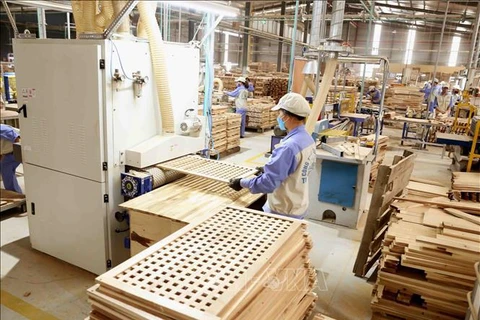
Hanoi (VNA) – Despite market recovery, the wood industry needs to overcome formidable challenges to realise the export revenue target of 15.2 billion USD for the whole year, according to insiders.
Director of the Department of Forestry under the Ministry of Agriculture and Rural Development Tran Quang Bao, said that the shipment of key products has gone up over the past time, including wood chips (38%), and wood and wooden products (over 20%), helping the industry gain 8.75 billion USD in revenue during January-July.
He held that high interest rates, trade tensions, and military conflicts have exerted pressure on the global economy, affecting demand for wood and wooden products in the remainder of the year. Major export markets like the EU, the US, Japan and the Republic of Korea are facing economic headwinds, and implementing various protectionist trade measures.
Although the US completed its investigation into the trade remedy duty circumvention of wooden cabinet products imported from Vietnam, the country will enhance control and post-clearance audits on the goods, as well as continue trade defence measures to support domestic enterprises, he said.
According to Chairman of the Vietnam Timber and Forest Product Association Do Xuan Lap, that the US Department of Commerce has not recognised Vietnam as a market economy means Vietnamese exports are challenged by anti-dumping and countervailing investigations. Furthermore, the actual production costs of Vietnamese enterprises are not recognised, instead, the "surrogate value" of a third country will be used to calculate dumping/subsidy margin in such cases.
In the Republic of Korea, its Trade Commission decided to continue levying anti-dumping tax between 9.78% and 32.28% on Vietnamese plywood in the next five years.
Meanwhile, the EU Deforestation Regulation (EUDR), taking effective from December this year, will create both opportunities and challenges for the industry. According to Chairman of the Forest Products Association of Binh Dinh province Le Minh Thien, if businesses adapt to the regulation, their competitive edge will be sharpened in this market. However, their failure to meet the EUDR means their products cannot sell into the market, and they will have to step out of the global supply chain.
Despite the peak shopping season in the end of the year, instability across the globe as well as high logistics costs will have a great impact on the wood sector.
Lap recommended enterprises focus on improve their competitive capacity based on the five pillars of production technique and technology, emissions reduction, digital transformation, trade promotion, and building of internal supervision standards.
Chairman of the Binh Duong Furniture Association Nguyen Liem said firms need to be flexible about their production and business, while developing technology and supply chain so as to grow sustainably./.






















